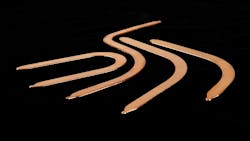Ultra-Slim "Capillary" Heat Pipes
Jaro Thermal's (maintenance free) Ultra-slim heat pipes use water as a "working fluid" that continually alternates between evaporation and condensation. This constant cycling of water to vapor.
is caused by a high-capillary mesh wick inside of the heat pipe. As the vapor travels away from the heat source, it cools and undergoes a phase change of condensation. Once the water is formed, the mesh wick captures the water and travels back down the wick to the heat source. As the water approaches the heat source, it undergoes a phase change of evaporation.
Cooling capacities range from 5 W up to 35 W. The minimum achievable thickness in the heat pipe is 0.6 mm, which makes it perfect for most confined-space requirements. In addition, the heat pipes are bendable, and can be pressed (for different height options). They can be ordered in different thickness levels, in either copper or aluminum. Applications include LED modules, tablet PCs, mobile phones and other electronic devices that require cooling within extreme space limitations. Specific examples include Intel's new low voltage chips, which run at 17 watts of power (in their next-gen Ultra-Book).
